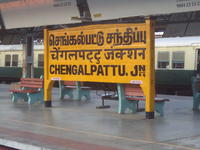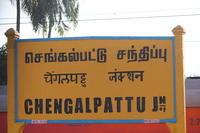|
| Post PNR | Post Blog | Advanced Search |
CGL/Chengalpattu Junction (9 PFs)चेंगलपट्टु जंक्शनசெங்கல்பட்டு சந்திப்பு

Track: Triple Electric-Line
चेंगलपट्टु जंक्शन
செங்கல்பட்டு சந்திப்பு
Track: Triple Electric-Line
Updated: Sep 26 2023 (10:25)
Junction Point-MS/AJJ(CJ)/VM. State Highway-58, JCK Nagar, Chengalpattu, Chengalpattu District, Pincode-603001 State: Tamil Nadu Elevation: 40 m above sea level Type: Junction Category: NSG-2Zone: SR/Southern Division: MGR Chennai No Recent News for CGL/Chengalpattu Junction Nearby Stations in the News | Number of Platforms: 9 Number of Halting Trains: 101 Number of Originating Trains: 0 Number of Terminating Trains: 0 | 0 Follows Rating: 3.7/5 (78 votes) cleanliness - good (10) porters/escalators - average (10) food - good (10) transportation - excellent (9) lodging - good (10) railfanning - good (9) sightseeing - good (10) safety - good (10) |
Nearby Stations
TRX/Tirumani 3 km RDY/Reddipalaiyam 5 km PWU/Paranur 5 km SKL/Singaperumal Koil 8 km VB/Villiyambakkam 8 km OV/Ottivakkam 9 km PALR/Palur 11 km PTM/Padalam 13 km MMNK/Maraimalai Nagar - Kamarajar 13 km CTM/Kattangulattur 14 kmStation News
Page# Showing 1 to 20 of 107 News Items next>>
Dec 04 2023 (19:15) Cyclone Michaung: Chennai-bound Pallavan, Vaigai expresses short terminated at Chengalpattu (www.thehindu.com)
News Entry# 532652 Past Edits
IR Affairs
SR/Southern
News Entry# 532652 Past Edits
Dec 04 2023 (19:15)
Station Tag: Chengalpattu Junction/CGL added by hrid22~/2099623
Station Tag: Chengalpattu Junction/CGL added by hrid22~/2099623
Trains: Pallavan Superfast Express/12605 Pallavan Superfast Express/12606 Vaigai SF Express/12635 Vaigai SF Express/12636
Stations: Chengalpattu Junction/CGL
Posted by: hrid22~ 8431 news posts
December 04, 2023 03:30 pm | Updated 03:30 pm IST - TIRUCHI
COMMents...
COMMents...
Oct 30 2023 (20:54) More than 50 suburban train services cancelled Beach-Chengalpattu section on October 31 (www.thehindu.com)
News Entry# 529486 Past Edits
IR Affairs
SR/Southern
News Entry# 529486 Past Edits
Oct 30 2023 (20:54)
Station Tag: Chengalpattu Junction/CGL added by hrid22~/2099623
Oct 30 2023 (20:54)
Station Tag: Tambaram/TBM added by hrid22~/2099623
Station Tag: Chengalpattu Junction/CGL added by hrid22~/2099623
Oct 30 2023 (20:54)
Station Tag: Tambaram/TBM added by hrid22~/2099623
Stations: Tambaram/TBM Chengalpattu Junction/CGL
Posted by: hrid22~ 8431 news posts
Oct 18 2023 (21:07) Tambaram-Villupuram MEMU special train to have additional stops (www.dtnext.in)
News Entry# 528309 Past Edits
IR Affairs
SR/Southern
News Entry# 528309 Past Edits
Oct 18 2023 (21:07)
Station Tag: Chengalpattu Junction/CGL added by hrid22~/2099623
Oct 18 2023 (21:07)
Station Tag: Tambaram/TBM added by hrid22~/2099623
Station Tag: Chengalpattu Junction/CGL added by hrid22~/2099623
Oct 18 2023 (21:07)
Station Tag: Tambaram/TBM added by hrid22~/2099623
Trains: Tambaram - Villupuram MEMU Express Special/06027 Villupuram - Tambaram MEMU Express Special/06028
Stations: Tambaram/TBM Chengalpattu Junction/CGL
Posted by: hrid22~ 8431 news posts
Oct 18 2023 (21:06) Railway Board allots ₹7.80 crore for survey work for 7 track expansion projects in Tamil Nadu (www.thehindu.com)
News Entry# 528308 Past Edits
IR Affairs
SR/Southern
News Entry# 528308 Past Edits
Oct 18 2023 (21:06)
Station Tag: Arakkonam Junction/AJJ added by hrid22~/2099623
Oct 18 2023 (21:06)
Station Tag: Chengalpattu Junction/CGL added by hrid22~/2099623
Oct 18 2023 (21:06)
Station Tag: Madurai Junction/MDU added by hrid22~/2099623
Oct 18 2023 (21:06)
Station Tag: Salem Junction/SA added by hrid22~/2099623
Oct 18 2023 (21:06)
Station Tag: MGR Chennai Central/MAS added by hrid22~/2099623
Station Tag: Arakkonam Junction/AJJ added by hrid22~/2099623
Oct 18 2023 (21:06)
Station Tag: Chengalpattu Junction/CGL added by hrid22~/2099623
Oct 18 2023 (21:06)
Station Tag: Madurai Junction/MDU added by hrid22~/2099623
Oct 18 2023 (21:06)
Station Tag: Salem Junction/SA added by hrid22~/2099623
Oct 18 2023 (21:06)
Station Tag: MGR Chennai Central/MAS added by hrid22~/2099623
Posted by: hrid22~ 8431 news posts
October 18, 2023 08:18 pm | Updated 08:18 pm IST - CHENNAI
COMMents...
COMMents...
Mar 20 2023 (19:14) PR No. 970 Extension of Special Trains between Ahmedabad and Tiruchchirappalli Sl. Tr. No. From-To Days of Run Extension Period No of services 1 09419 Ahmedabad – Tiruchchirappalli Thursday (Weekly) 06.04.2023 (scr.indianrailways.gov.in)
News Entry# 510891 Past Edits
Other News
SCR/South Central
IR Press Release
News Entry# 510891 Past Edits
Mar 20 2023 (19:15)
Station Tag: Tiruchchirappalli Junction/TPJ added by Manoj851120~/2148114
Mar 20 2023 (19:15)
Station Tag: Ahmedabad Junction/ADI added by Manoj851120~/2148114
Station Tag: Tiruchchirappalli Junction/TPJ added by Manoj851120~/2148114
Mar 20 2023 (19:15)
Station Tag: Ahmedabad Junction/ADI added by Manoj851120~/2148114
Trains: Ahmedabad - Tiruchchirappalli Special Fare Special/09419 Tiruchchirappalli - Ahmedabad Special Fare Special/09420
Stations: Ahmedabad Junction/ADI Vadodara Junction/BRC Surat/ST Vapi/VAPI Vasai Road/BSR Kalyan Junction/KYN Pune Junction/PUNE Guntakal Junction/GTL Mantralayam Road/MALM Raichur Junction/RC Wadi Junction/WADI Solapur/SUR Arakkonam Junction/AJJ Chennai Egmore/MS Tambaram/TBM Chengalpattu Junction/CGL Villupuram Junction/VM Tiruchchirappalli Junction/TPJ Renigunta Junction/RU Kadapa Junction (Cuddapah)/HX Tadipatri/TU Perambur/PER Kumbakonam/KMU Thanjavur Junction/TJ Papanasam/PML Sirkazhi/SY Chidambaram/CDM Kalaburagi Junction (Gulbarga)/KLBG
Posted by: Manoj851120~ 101 news posts
In order to clear the extra rush of passengers, Railways will continue to run the following special trains between Ahmedabad – Tiruchchirappalli – Ahmedabad as detailed...
Page# Showing 1 to 20 of 107 News Items next>>


